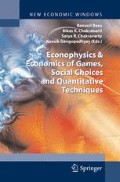Abstract
This paper determines the distribution of income that maximizes aggregate saving when the economy meets the restrictions that the mean income and level of social welfare are given. Presuming that the aggregate demand in the economy consists of the sectoral demand components, consumption and investment, the determined distribution is the one of a given total, that maximizes the funds that can be generated for investment without any loss of welfare. The saving function is assumed to be of Keynesian type: the marginal propensity to save is less than unity and the average propensity to save is increasing with income. The social welfare function we employ here is the single parameter Gini social welfare function introduced by Donaldson and Weymak (1983). If social welfare is assumed to be measured by the Gini social welfare function, then for a simple saving function, the resulting distribution turns out to be the Pareto. We also present an alternative unrestricted maximization of the aggregate saving function and look for the underlying income density function.We finally demonstrate that the Pareto income distribution is completely identifiable for the prespecified levels of welfare and the mean of the income distribution.
Access this chapter
Tax calculation will be finalised at checkout
Purchases are for personal use only
Preview
Unable to display preview. Download preview PDF.
References
Becker, G. and Tomes, N. (1979). An Equilibrium Theory of the Distribution of Income and Intergenerational Mobility. Journal of Political Economy 87, 1153–1189
Chakravarty, S.R. (2009). Inequality, Polerization and Poverty: Advancer in Distributional Analysis. Springer, New York
Champernowne, D.G. (1953). A Model of Income Distribution. Economic Journal 63, 318–351
Chipman, J.S.(1974). The Welfare Ranking of Pareto Distributions. Journal of Economic Theory 9, 275–282
Courant, R. and Hilbet, D. (1953). Methods of Mathematical Physics, Vol.1. Wiley Inter-Science, New York
Donaldson, D. and Weymark, J.A. (1983). Ethically Flexible Gini Indices of Inequality for Income Distributions in the Continuum. Journal of Economic Theory 29, 353–358
Eckstein, Z., Eichenbaum, M.S. and Peled, D. (1985). The Distribution of Wealth and Welfare in the Presence of Incomplete Annuity Markets. Quarterly Journal of Economics 99, 789–806
Jerison, M. (1994). Optimal Income Distribution Rules and Representative Consumers. Review of Economic Studies 61, 739–771
Loury, G.C. (1981). Intergenerational Transfers and the Distribution of Earnings. Econometrica 49, 843–967
Shorrocks, A.F. (1975). On the Stochastic Models of Size Distributions. Review of Economic Studies 42,631–641
Wold, H.O.A. and Whittle, P. (1957) A Model Explaining the Pareto Distribution of Wealth. Econometrica 25, 591–595
Yoshino, O. (1993). Size Distribution of Workers Household Income and Macroeconomic Activities in Japan: 1963–88. Review of Income and Wealth 39, 387–402
Author information
Authors and Affiliations
Editor information
Editors and Affiliations
Rights and permissions
Copyright information
© 2010 Springer-Verlag Italia
About this paper
Cite this paper
Chakravarty, S.R., Ghosh, S. (2010). A Model of Income Distribution. In: Basu, B., Chakravarty, S.R., Chakrabarti, B.K., Gangopadhyay, K. (eds) Econophysics and Economics of Games, Social Choices and Quantitative Techniques. New Economic Windows. Springer, Milano. https://doi.org/10.1007/978-88-470-1501-2_21
Download citation
DOI: https://doi.org/10.1007/978-88-470-1501-2_21
Publisher Name: Springer, Milano
Print ISBN: 978-88-470-1500-5
Online ISBN: 978-88-470-1501-2
eBook Packages: Business and EconomicsEconomics and Finance (R0)

